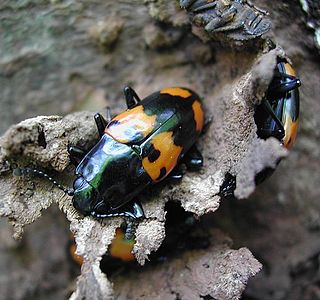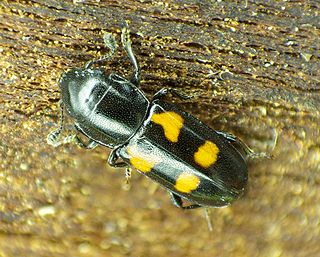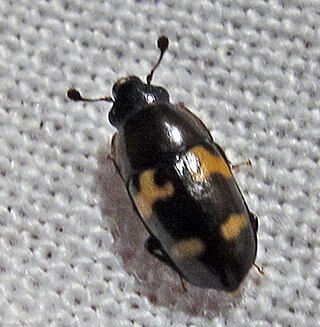
The sap beetles, also known as Nitidulidae, are a family of beetles.

Convolvulaceae, commonly called the bindweeds or morning glories, is a family of about 60 genera and more than 1,650 species. These species are primarily herbaceous vines, but also include trees, shrubs and herbs. The tubers of several species are edible, the best known of which is the sweet potato.

Gifford Pinchot National Forest is a National Forest located in southern Washington, managed by the United States Forest Service. With an area of 1.32 million acres (5300 km2), it extends 116 km (72 mi) along the western slopes of Cascade Range from Mount Rainier National Park to the Columbia River. The forest straddles the crest of the South Cascades of Washington State, spread out over broad, old growth forests, high mountain meadows, several glaciers, and numerous volcanic peaks. The forest's highest point is at 12,276 ft (3,742 m) at the top of Mount Adams, the second tallest volcano in the state after Rainier. Often found abbreviated GPNF on maps and in texts, it includes the 110,000-acre (450 km2) Mount St. Helens National Volcanic Monument, established by Congress in 1982.

The bull trout is a char of the family Salmonidae native to northwestern North America. Historically, S. confluentus has been known as the "Dolly Varden", but was reclassified as a separate species in 1980. Populations of bull trout in the lower 48 states are listed as threatened under the U.S. Endangered Species Act, and bull trout overall are listed as vulnerable to extinction on the IUCN Red List of Threatened Species. The Saskatchewan-Nelson Rivers population in Alberta, Canada is listed as threatened under the Species at Risk Act.

The Sawtooth Wilderness is a federally-protected wilderness area that covers 217,088 acres (87,852 ha) of the state of Idaho. Managed by the U.S. Forest Service in the U.S. Department of Agriculture, it was designated the Sawtooth Primitive Area in 1937 to preserve the scenic beauty of the Sawtooth Mountains. On August 22, 1972 Public Law 92-400 designated the Primitive Area as the Sawtooth Wilderness and part of the newly created Sawtooth National Recreation Area. As part of the National Wilderness Preservation System, the Sawtooth Wilderness is an area where human development and use are restricted and people are to remain only visitors. According to the United States Environmental Protection Agency, the Sawtooth Wilderness has some of the clearest air in the lower 48 states.

Crotalus oreganus abyssus is a venomous pit viper subspecies found only in the U.S. states of Arizona and Utah.
Zappa confluentus, the New Guinea slender mudskipper, is a mudskipper endemic to New Guinea, where it is only known from the lower parts of the Fly, Ramu and Bintuni Rivers. It is found on mudflats adjacent to turbid rivers. This species can reach a length of 4.4 centimetres (1.7 in) SL.

Megalodacne is a genus of fungivorous beetles in the family Erotylidae.

Glischrochilus[note 1] is a genus of sap-feeding and predatory beetles under the family Nitidulidae, subfamily Cryptarchinae. Most members of this genus are commonly known as picnic beetles or beer bugs.

Glischrochilus hortensis is a species of beetle in the genus Glischrochilus of the family Nitidulidae. The genus are commonly known as 'sap-beetles'.

Glischrochilus quadripunctatus, commonly known as the European bark beetle predator is a species of beetle in the genus Glischrochilus of the family Nitidulidae.

Glischrochilus quadrisignatus, known generally as four-spotted sap beetle, is a species of sap-feeding beetle in the family Nitidulidae. Other common names include the beer bug and picnic beetle. It is found in North America.
Cryptocephalus confluentus is a species of case-bearing leaf beetle in the family Chrysomelidae. It is found in North America.
Glischrochilus obtusus is a species of sap-feeding beetle in the family Nitidulidae. It is found in North America.
Glischrochilus sanguinolentus is a species of sap-feeding beetle in the family Nitidulidae. It is found in North America.
Glischrochilus vittatus is a species of sap-feeding beetle in the family Nitidulidae. It is found in North America.
Sunius is a genus of rove beetles in the family Staphylinidae. There are more than 60 described species in Sunius.

Glischrochilus fasciatus, the picnic beetle, is a species of sap-feeding beetle in the family Nitidulidae. It is found in Central America and North America.
Postelichus is a genus of long-toed water beetles in the family Dryopidae. There are at least four described species in Postelichus.
Glischrochilus siepmanni is a species of sap-feeding beetle in the family Nitidulidae. It is found in North America.










